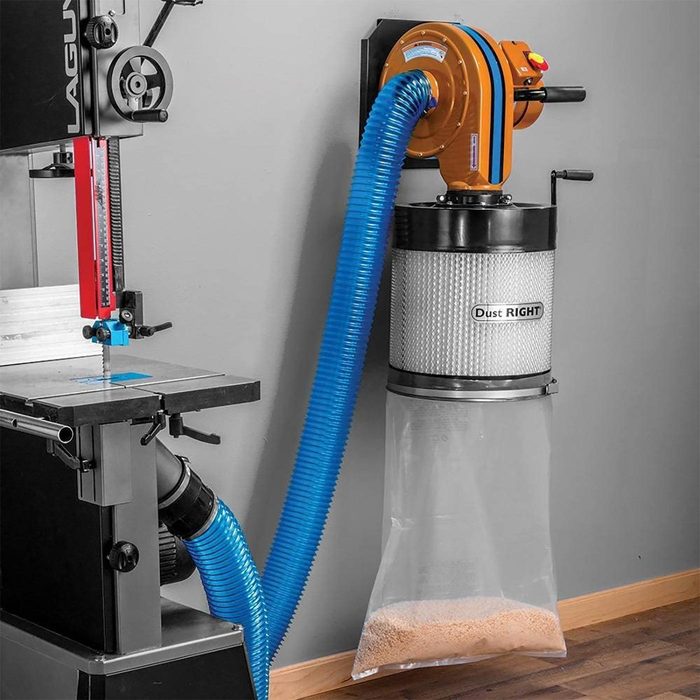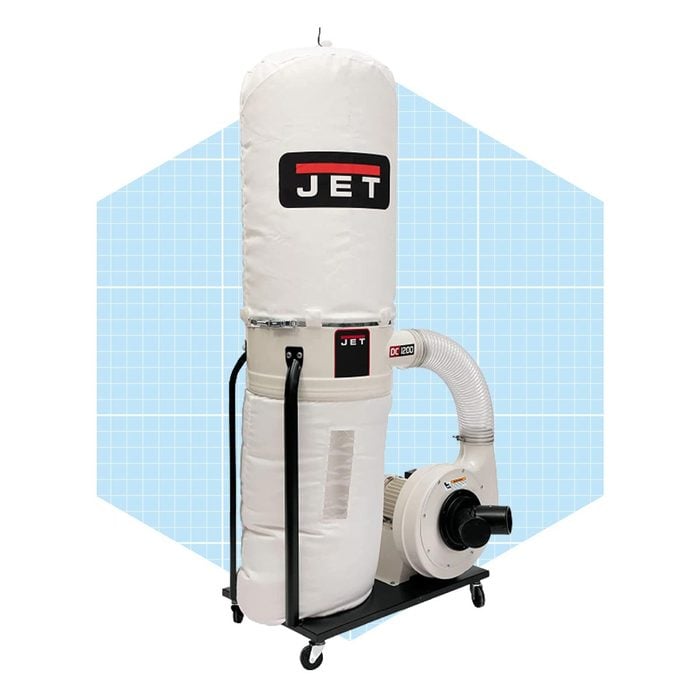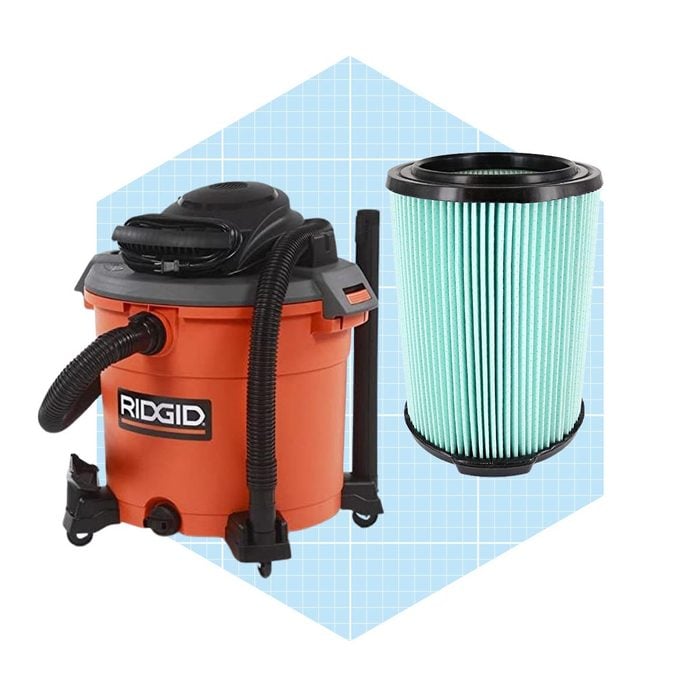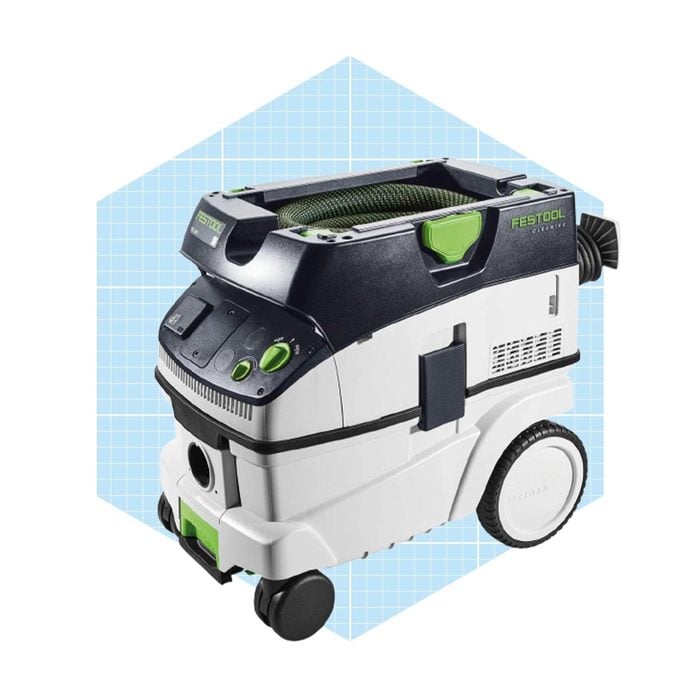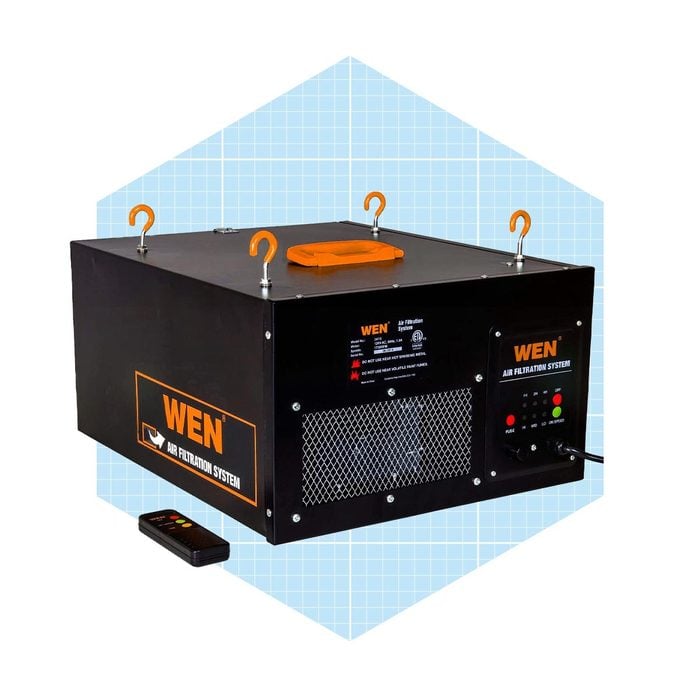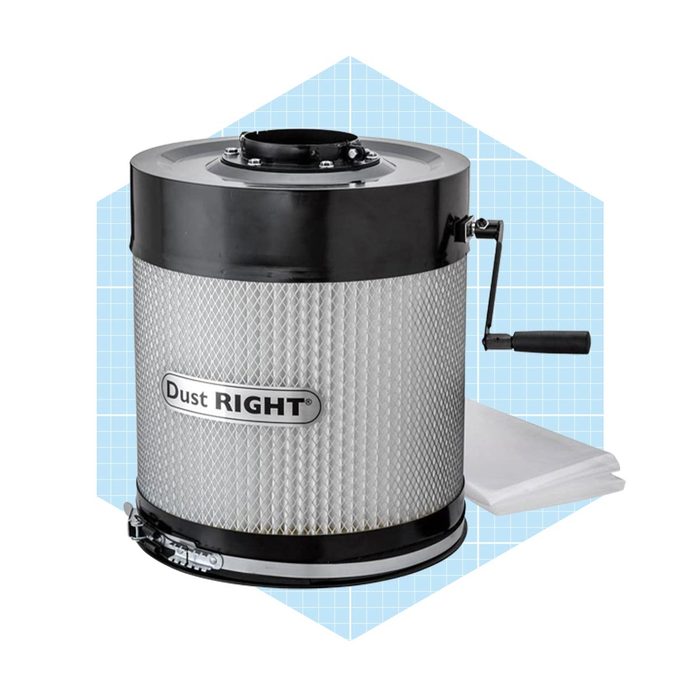Best Overall
Jet Vortex Cone Dust Collector
The Jet Vortex Cone is quite popular, as evidenced by its stellar dust collection reviews. But what gives it an edge over the others? A two-horsepower motor, and vortex cone technology that guarantees continuous, systematic air movement. This feature allows for better chip separation, less clogging of the filter and increased packing efficiency of the collector bag.
It takes a single-stage design approach, adding the separation efficiency of a two-stage dust collection system while still keeping the operation quiet. This machine also features a fully enclosed, fan-cooled two-horsepower motor with continuous duty, meaning there’s more than enough horsepower to make sure you’re getting efficient air movement.
The Jet Vortex boasts a collection capacity of 5.3 cubic feet, and the 1,200 cfm (cubic feet per minute) stands up to its competitors. Collection bags have a sewn-in snap ring for fast and easy installation and removal. Its dual four-inch dust ports allow you to connect two machines at the same time—perfect for any workshop.
Pros
- Fan-cooled motor enables continuous usage
- Quick connect bag system
- Strong steel construction
- Four swivel casters
Cons
- Bulky
- On the heavier side
Best Budget
Rigid Wet/Dry Vac With Cyclonic Dust Bags
If you’re wondering, can wood make you sick? The short answer is yes, which is why dealing with it so important. But if a dust collector is too costly or bulky, you can make a budget system yourself with just a few upgrades to your wet/dry vac. One upgrade is to add HEPA filtration to your shop vac.
When the HEPA filter and dust bag are used together, it removes 99.97% of all particles 0.3 microns and larger from the air. These dust bags are uniquely shaped like a ring instead of the typical U-shaped bags. This allows for cyclonic airflow, meaning dust distributes more evenly throughout the bag.
Another upgrade you can make to your shop vac is with a cyclone separator. A popular one is the Dust Deputy separator, which captures about 98% of the dust in the five-gallon bucket, leaving the filter on your shop vac cleaner and running more efficiently.
Pros
- Budget-friendly
- Highly mobile and dual purposed (wet/dry)
- Excels at capturing dust from a single tool
Cons
- Limited by its capacity, power and filtration
Best Suction
Shop Fox Dust Collector
The Shop Fox Dust Collector is portable without sacrificing on horsepower. It generates 1,280 cfm of air suction to capture dust from your bigger machines. It has a 2.5-micron felt upper filtration bag, which means it can defeat dust and get lots of fine particles out of the air. This unit packs a punch for its size and price range. This heavy-duty dust collection machine has powder-coated paint to prevent rust, and is made primarily with steel so it’s durable and strong as well.
It sports a steel impeller to handle the wood debris that passes through to the 2.5-micron filter bag. Unlike plastic impellers, the Shop Fox steel impeller offers long lasting performance. It also features a removable Y-fitting and dual four-inch openings. The Y-fitting allows you to service more than one machine at a time. If you’re looking for a convenient multi-machine layout, this is the way to go.
Pros
- High suction
- Scratch-resistant coating
- Steel frame ensures durability
- Dual 4-inch intake ports
- Powder dust-coated paint
Cons
- Caster wheels don’t swivel easily
Best for Hand Tools
Festool HEPA Dust Extractor
The HEPA-certified Festool Dust Extractor offers the ultimate in clean air and filtration with minimal noise at only 62 decibels. It comes with a powerful motor that can produce 137 cfm, and the total capacity of the dust container is just under seven gallons.
The dust collector is compatible with Festool tools, so no more swapping adapters. It’s equipped with tool triggered auto start, so the vacuum is on only when you need it. Navigation is a breeze with extra large wheels and a parking brake to prevent unintentional roll off or drifting.
Pros
- Compatible with Festool tools
- Impressive suction power
- Automatic turn on feature
- Long power cord
- Low noise
Cons
- Only two of the four wheels swivel
Most Quiet
Laguna B-Flux Dust Collector
The Laguna B-Flux Dust Collector is a one-horsepower unit offering 99.97% dust filtration through its one-micron canister. It’s impressively quiet with a 76 decibel rating, which allows you to work on any woodworking project in peace. The horizontal dust chute provides optimum airflow and can swivel 180 degrees to make the four-inch outlet face downwards. It’s compact and mobile—wheel it to the machine you’re using and store it away when finished.
Pros
- Very quiet
- Four casters for portability
- Sleek design
- Snap band makes changing the bag a breeze
- Easy to assemble
Cons
- Non-HEPA filter
Best Air Scrubber
Wen Air Filtration System
The Wen multi-speed air filtration system has a strong one-sixth horsepower motor, and weighs just 31 pounds. The lightweight design paired with the carrying handle and eye-bolts make this machine exceedingly portable. This Wen machine pushes air through a five-micron outer filter and a one-micron inner filter, then releases it back into the workshop.
You can also choose three speeds and use the timer function to filter the air in the room at regular intervals. The Wen also comes with a remote that has a range of up to 26 feet. This is the crown jewel of air scrubbers and one of the quietest on the market, emitting just 50 to 60 decibels.
Pros
- Eradicates air contaminates with two filters
- Reasonably priced
- Clear instructions and easy installation
- Quieter than expected
- Timer function
Cons
- Remote is limited to 26 feet
Best Wall Mount
Rockler Dust Right Wall Mount Dust Collector
This wall-mounted dust collector has an extra small footprint, making it the perfect choice for a shop when space is at a premium. The machine moves 650 cfm of suction power through a 4-inch inlet. The Dust Right operates at about 85 decibels, staying just below the harmful noise level.
Included in the kit is a 30-micron bag with a clear window to see when the bag is getting full. This bag will filter out the bulk of the wood dust, but not fine dust. You can upgrade to a 5-micron bag filter and, for even more filtration, upgrade to a 1-micron canister filter.
Pros
- Mounts off the floor freeing up space
- Snap band ring makes changing the collection bag easier
- Crank style filter cleaner
Cons
- Lacks a cyclone stage, which would cut down on bag changes
What to Consider When Buying a Dust Collector
Before deciding on a dust collector, it’s important to evaluate what you need. Put simply, your dust collector needs to pull more air (rated in cfm) than your most air-hungry tool (and the ductwork) requires. There are other factors to consider, like the level of air filtration and the collection bag capacity.
If you’re just getting started in woodworking and have minimal capital to invest in large stationary tools, consider a small portable dust collector. They’re designed to be very manageable and moved around the shop from tool-to-tool as needed. However, you’ll sacrifice the cyclone system that separates chips and dust, resulting in more dust reaching the pleated filter. This means cleaning the filter more often.
Consider replacing stock bags with felt bags rated at five microns or less. Dust particles under 10 microns are the most harmful for your lungs, and standard bags are good at capturing particles of 25 microns or bigger. Also, check the noise output to make sure it’s not too loud.
Types of Dust Collectors
There are several types of dust collection products available, with the main differences being the power, portability and dust collection capacity.
- Shop vacs: This is an affordable option best used for smaller tools and to pick up random debris such as screws. You will have to empty the vacuum more often, and the filter clogs more frequently. The filtering capacity of a shop vac is not nearly as strong as a dust collector, but there are ways to improve it.
- Dust Extractors: These are designed to collect dust from handheld power tools. Dust extractors, like the Festool HEPA version, can be extraordinarily quiet with a tool-activated switch that turns the extractor on automatically.
- Single-Stage Dust Collectors: Two-bag, single-stage dust collectors work by transporting sawdust and wood chips through an impeller on the way to a collection bag. The heavier particles and debris then settle in the lower bag. It’s a simple design with a higher horsepower output that lets you connect to larger tools like a table saw or planer. They come in various designs: upright, wall-mount or handheld.
- Cyclonic Canister Dust Collectors: This type has a higher airflow and two-stage dust separation, separating smaller dust particles from larger pieces. As a result, the finer dust particles pass through the impeller and into the filter. The canister filter is excellent at capturing one-micron and two-micron dust particles effectively.
How We Found the Best Dust Collector
As shopping experts, our only job is to help you find a winning product. We start with the research and reporting basics—what products are made of, what they look like and how much they cost—to ensure that we’re only recommending the buys that are worth your time and money. Then, we research the features that speak to the product’s quality, taking advice from industry insiders and subject matter experts on what makes a product a smart value (or worthy of a splurge). Finally, we do the work of combing through user reviews to see how real people interact with the product, and if it stands up to the test.
FAQ
How big of a dust collector do I need?
Cubic feet per minute (cfm) and horsepower (hp) are two essential features to consider when understanding how big of a dust collector you need. Horsepower determines how strong the dust collector motor is, and the cfm is the amount of airflow the collector generates.
Medium sized dust collectors are typically around one horsepower and 700 cfm. If your workshop has two or three power tools, then a one horsepower, 700 cfm dust collector will be the smartest choice. Larger shops with multiple stationary power tools should use collectors that are around one-and-a-half horsepower with 1,200 cfm.
How does a dust collector work?
A dust collector has high air flow and low suction, which is why lighter sawdust gets picked up by the hose, but it can’t pick up large pieces like screws. The dust collector’s motor drives an impeller fan that generates a large volume of air flow that moves dust and debris from woodworking tools. There are many types of dust collectors, but they all have a larger hose than shop vacs and a more powerful motor.
Is a dust collector better than a shop vac?
A shop vac is meant for general cleanup and to keep surfaces clear of sawdust, not the air. If your smaller tool has a two-inch or smaller dust port, a shop vac will be adequate. A larger tool like a table saw, jointer or planer is going to create a large amount of wood chips and quickly overwhelm a shop vac.
Dust collectors are made specifically for a wood shop. They move higher quantities of air, catching the finer dust particles in the filter. Dust collectors handle significantly more sawdust quicker and experience less drop off in performance further away from the source because of the greater volume of air it is moving.
Shop smarter with our expert recommendations for tools, gear and money-saving deals on can’t miss DIY and home products. Sign up for the Stuff We Love newsletter.

